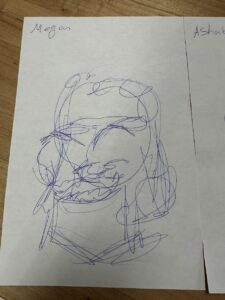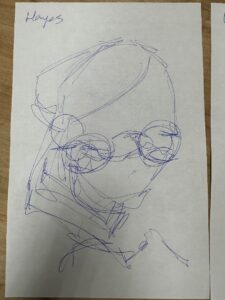by Katie White
Hey y’all! I’m Katie, a Studio Assistant here at Ignite, and today I’m gonna show you a fun exercise to help improve drawing skills! This exercise is called blind contour. What is blind contour drawing? Well contour means the outline or shape, and is used to describe the lines the make up the outside edge of a drawing. This is a great exercise to experiment with when you check out one of Ignite’s sketching and drawing kits.

It’s a BLIND contour because you won’t be looking at your drawing until its complete.

What is Blind Contour Drawing?
When drawing, you look at your subject, then glance down and use short-term memories to copy what you saw to paper. The problem with memory is that it isn’t entirely accurate and can often omit small, yet important details. By not looking down at your paper, you’re forced to see your subject as a series of lines and shapes rather than, say, a face with a nose and eyes. This can improve the connection between your pencil and your brain, so that you don’t have to look down as often!

The blind contour line drawing technique was first used in the 1920s and 1930s, brought to mass attention in the art world in Kimon Nicolaïdes 1941 book, The Natural Way to Draw: A Working Plan for Art Study. It’s a great technique for beginner artists to use when focusing on observational skills, and it builds an excellent foundation for more complex artistic adventures later on. Your final drawing is usually not very realistic and can look a little messy, but that’s exactly how it’s meant to be!
What you’ll need:
- Paper
- Pencil/ pen
- Something to draw (subject)
- Timer (optional)

To start, find something, or someone to draw. Blind contour is supposed to be a quick, messy sketch, so a timer set to between one to five minutes can be helpful for keeping you on track. For this blog, I chose to draw some of the staff here at Ignite, and set a timer for 60 seconds. When you’re all set up, go ahead and begin!

(tip: Many blind contour drawings are made of one continuous line. The pencil or pen stays on the paper so that the artist doesn’t lose where they are or need to look down.

If you want to make your drawing a little more exciting, you can add color! Once your sketch is done, fill in the spaces between the contour lines with marker, colored pencil, or crayon. You can go the naturalistic route and use the colors you see in your subject, or go more impressionist and use the full rainbow! Practice your blind contour drawing skills and share your results on our Ignite Community Discussion Board. Happy Making!


